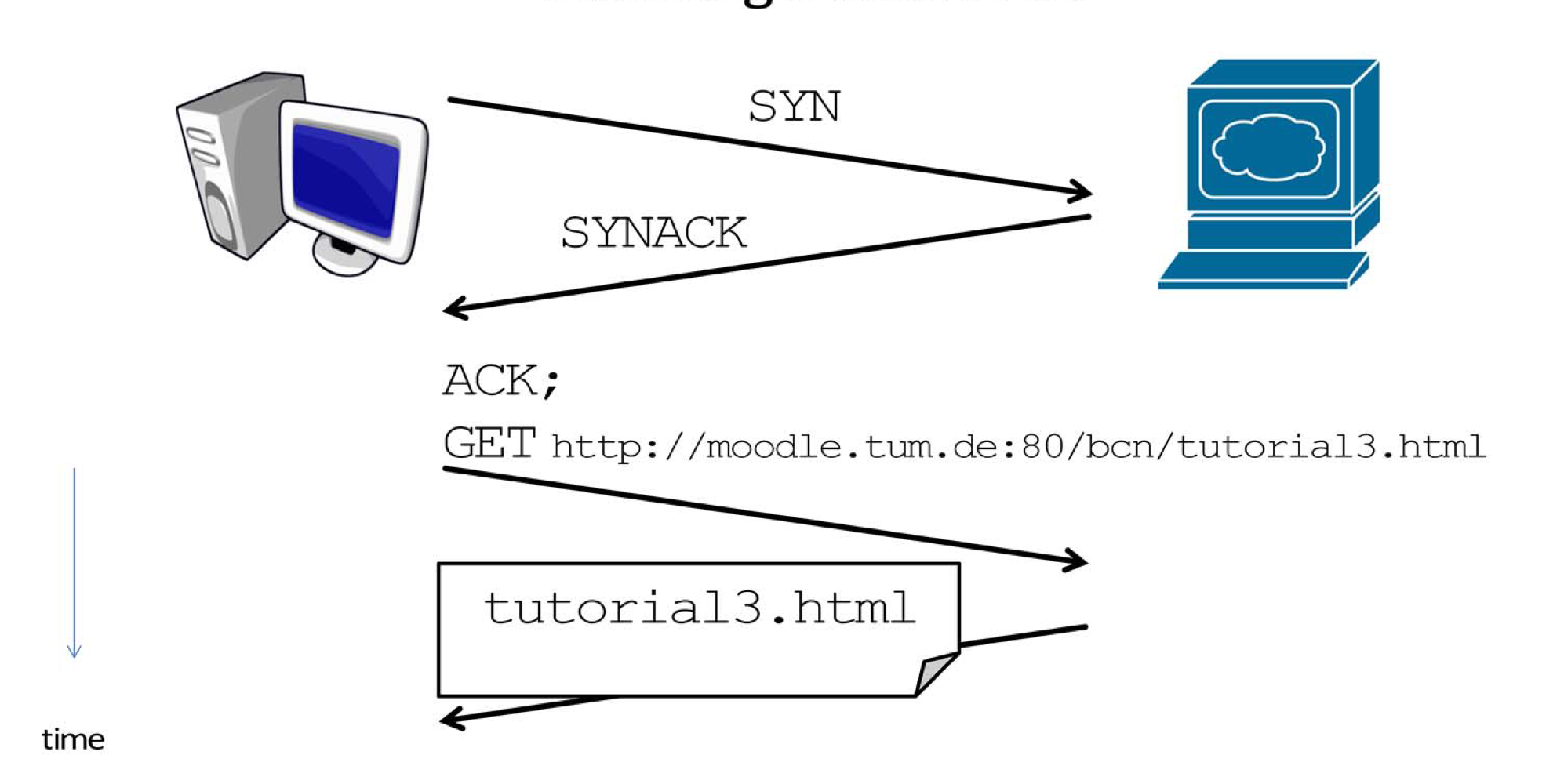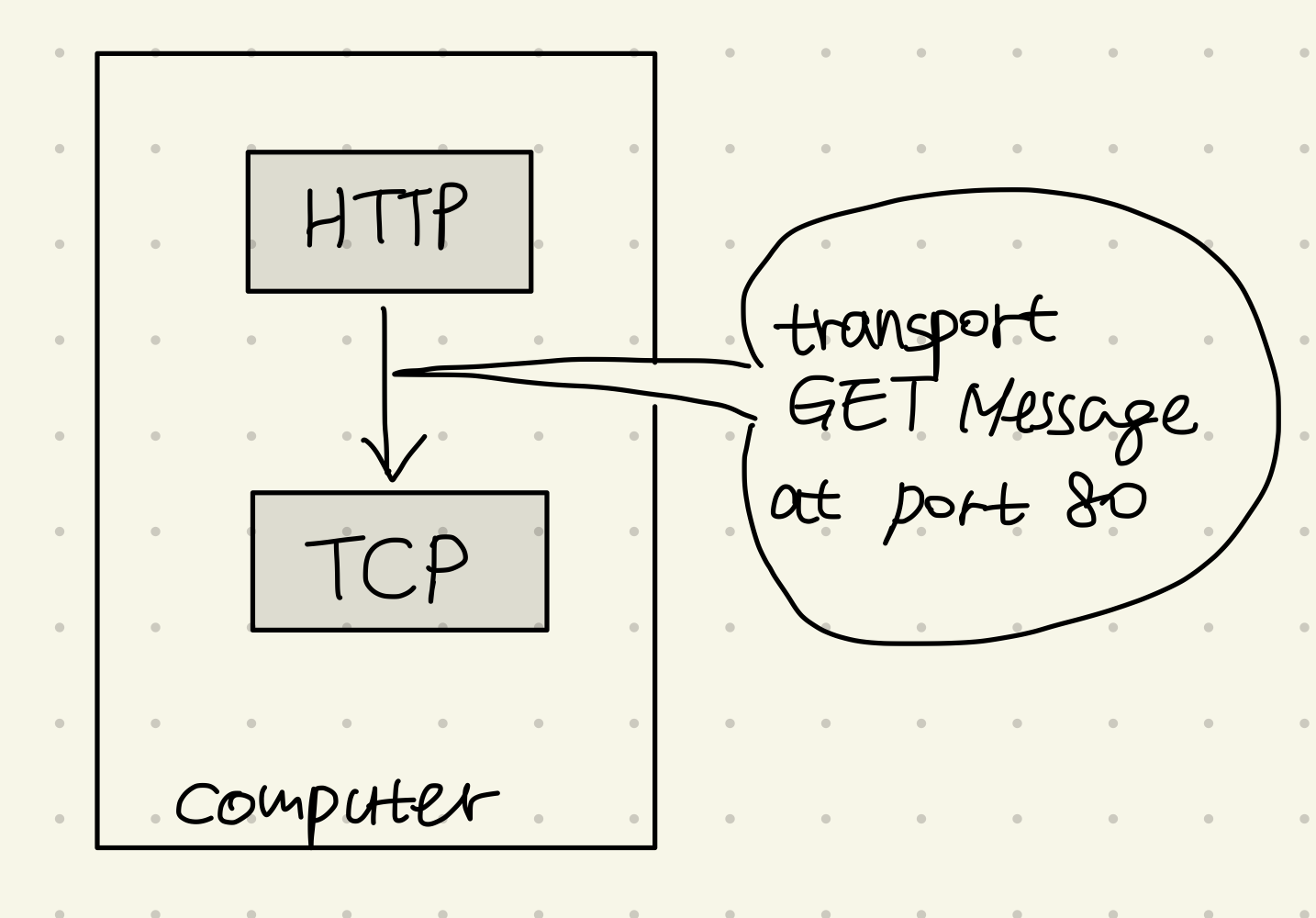Organization
1. Definition of protocols
2. Protocol Stack
3. Adding Network elements: Switch
4. Example
What is a protocol? - an analogy
In a typical daily life conversation, we can observe clear rules Alice and Bob are following while talking to make this conversation a successful conversation.
Rules
- Do not talk at the same time
- Request requires reponse
- Specific requests require spefici responses
We call these rules a "protocol" for a successful conversation. Here is an example for a conversation between two computers. Suppose that left side is an office PC and on the right side a web server. Again the time axis is going downwards.

1. The office PC starts to connect with the web server using the SYN message.
2. The web server responds with a SYN‐ACK message.
3. The office PC confirms the connection with an ACK message followed by a request message for an URL.
4. The answer of the webserver is a message containing the content of the respective web page tutorial3.html
As we can observe, the same set of rules have to be followed to have a successful conversation between computers:
This means, an ACK without a preceding SYN and SYNACK would not lead to a successful connection setup. And further the office PC would not be able to handle the tutorial3.html if it had not requested it with a GET message.
A Communication Protocol defines a set of rules for the communication between entities in terms of messages, the format of the exchanged information packets, and the addresses of the entities.
We know already from our experience that there are many protocol typically running between computers in the internet.

- HTTP : web page donwonload
- SMTP : email
- SIP : voice over IP
- TCP, UDP : general transport protocols
- IP : routing in the internet, to finde a path to another computer
- Ethernet : transmission of packets over optical fiber or over twisted pair cable
- WLAN : transmission of packets over the 5 or 2,5 GHz frequency bands
Protocol Stack
We have just discussed that there are many protocols existing with different focus of their rules.
In fact, due to the high number of rules and their complexity implementing all rules in one protocol would become very complex.
 |
 |
Moreover the protocols and their services have been categorized. These protocol categories are called protocol layers. All protocol layers form a protocol stack.
In a worldwide standardization effort called OSI ‐ Open System Interconnect ‐ seven layers have been defined and standardized.
OSI Model for 7 Protocol Layers
- Layer 7 : all protocols of implementing application specific details. Hyper Text Transfer Protocol for accessing web servers.
- Layer 6 : related to data presentation and formatting protocol tasks.
- Layer 5 : the session layer, They are establishing end‐to‐end sessions between users.
- Layer 4 : the transport layer, To transport typically independent of the transmission medium. eg, TCP, UDP.
- Layer 3 : the network layer. To support the routing of packets inside a network. The Internet Protocol IP is the main protocol of this layer.
- Layer 2 : the data link layer. To realize the access to a transmission medium and the point‐to‐point data transport over the medium.
- Layer 1 : the physical layer comprising all functionality for the transmission of data bitwise over the transmission media. Only bits in Layer 1 are actually transmitted over the transmission medium.
The other protocols use this transmission service via the protocol stack.
Layer 7 \(\rightarrow\) Layer 6 \(\rightarrow\) ... \(\rightarrow\) Layer 1
Whereas the application layer protocol process is formulating a request to a web server, this request is actually handled by each other layer to perform the respective service of each layer. The lower layers add information to the request, for implementing specific rules, for example for error handling, fast transport, addresses, routing.
Finally the bits are sent out over the transmission medium by the layer 1 protocol to another computer.
the bits recieved are handled by each layer. Logically the protocol processes on layer 7 are communicationg with each other, but the physical bit-wise communication is only perfomred at the physical layer.
Whereas 7 layers have been standardized, in today's mostly deployed network.

In this way, we understand the categorization that we have done previously better as we can relate the different protocols used in the internet to the 5 protocol layers.
The GET message has to be transported to the web server.
TCP trnasport the GET message to the web server, adds information in the TCP header to the application layer message and adds a sequence number to guarantee a sequential delivery.
IP Protocol asks the link layer protocol to transmit the packet with all headers over the next hop specific medium to the next node.
Ethernet layer 2 protocoal adds sthe ethernet header with the ethernet specific address
Bits are transmitted over the cable and will be received by the physical layer of the second computer that might already host the web server. Bits are only transmitted on the physical layer.
The other layers have a logical communication with their counterpart protocol process on the computer 2.
Adding Network elements: Switch
A switch is only responsible to forward data packets between two transmission mediums.
e.g. Router

A router is forwarding data packets in the worldwide Internet. So a router has to process layer 3 information, which contains the IP address. However, layer 4 and above headers remain unchanged.
Example
What to do : to display the web page in the web browser of my laptop.
- To send the HTTP Request : Clinet establishes a TCP connection to the webserver for the data packet transport
- HTTP Request is sent
- Packet with HTTP Request routed to web server.
- web server replies with HTTP Response.
- Packet with HTTP Response routed back to client.
- web page is displayed




댓글